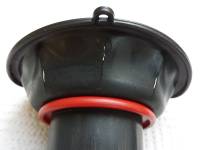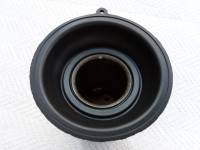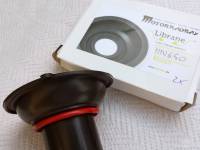This is an old revision of the document!
Table of Contents
Honda NTV650 Revere - Carburetor
The Honda NTV650 Revere mounts two Keihin vacuum piston carburetors. Each carburetor has also an air cut-off valve driven by a small membrane.
Replacing the diaphragms
Replacing the diaphragms at 100.000 and 200.000 km
I replaced the complete vacuum cylinders with diaphragms the first time after 12 years, at 113,000 km. After another 12 years (24 years and 201,000 km in total) the diaphragms were again to be changed as shown in the photo:
Unfortunately, mother Honda no longer produces the spare part (code 16112MN8014)! There are at least three types of non-original membranes adaptable to the NTV650, which differ in the way they are installed. One type requires cutting the upper plastic ring (the black one) which is then put back in place and glued. A second type requires that the black ring be removed and thrown away (it is the Librane model seen in the following photos), the replacement membrane is held in place with cyanoacrylate glue. The glue supplied is gel type, resistant to petrol and high temperatures. Finally, there is a model that must be installed like the original, inserting it in the space between the red and black rings.
The following photos show the installation of a Librane type membrane.
Before removing the old membrane mark the point on the piston that corresponds to the membrane slot, because the new one will have to be positioned at exactly the same angle. The black ring can be cut with a cutter and removed. The groove can be cleaned and degreased with synthetic thinner. Be careful to spread a very thin layer of glue, so that the membrane enters well into the housing without encountering any thickness.
As soon as they were mounted, the result seemed good: the precision and sensitivity of the throttle was significantly improved compared to the old cracked membranes. In a few months I will check the actual seal of the membrane and especially of the glue. The one supplied reports among its characteristics a maximum operating temperature of 80 °C. Probably the Loctite 454 has better characteristics.
Jets
The main jets are different sizes in the front and rear cylinder carburetors.
| Carburetor | Main Jet |
|---|---|
| Right (front cylinder) | # 140 |
| Left (rear cylinder) | # 135 |
The air cut off valve
![]() The Keihin carburetors on the NTV650 Revere feature the so-called air cut-off valve, a device that serves to enrich the air-fuel mixture when the throttle is closed and the engine has not yet slowed down (for example when using engine braking on a downhill run). In this condition, the cylinder sucks in with greater force than at normal idle, the idle jet therefore supplies a mixture that is too lean and the afterburn phenomenon occurs. Afterburn is the popping of the engine caused by a mixture that is too lean and cannot ignite in the combustion chamber. The unburned gasoline passes into the exhaust pipe and here, due to the high temperature, it ignites, producing the annoying explosions.
The Keihin carburetors on the NTV650 Revere feature the so-called air cut-off valve, a device that serves to enrich the air-fuel mixture when the throttle is closed and the engine has not yet slowed down (for example when using engine braking on a downhill run). In this condition, the cylinder sucks in with greater force than at normal idle, the idle jet therefore supplies a mixture that is too lean and the afterburn phenomenon occurs. Afterburn is the popping of the engine caused by a mixture that is too lean and cannot ignite in the combustion chamber. The unburned gasoline passes into the exhaust pipe and here, due to the high temperature, it ignites, producing the annoying explosions.
The cut-off valve circuit is a duct that complements the idle circuit and contributes for its own part to the air-fuel mixture for the correct idle functioning. The difference is that in this circuit the air duct can be closed, temporarily creating a greater supply of gasoline. The cut-off valve is operated by a membrane connected to the intake manifold: when the vacuum is very high (high rotation speed and closed throttle valve) the membrane closes the cut-off air duct; the result is a richer mixture that avoids afterburn. When the engine speed drops, the vacuum becomes lower and the cut-off valve returns to its rest position; the idle circuit is then returned to normal condition.
![]() I carburatori Keihin della NTV650 Revere montano la cosiddetta valvola air cut-off, si tratta di un dispositivo che serve ad arricchire la miscela aria-benzina quando si chiude il comando del gas e il motore non ha ancora diminuito il numero di giri (ad esempio quando si usa il freno motore in discesa). In tale condizione il cilindro aspira con una forza maggiore rispetto al normale regime del minimo, il getto del minimo fornisce quindi una miscela troppo magra e si ha il fenomeno dell'afterburn. L'aferburn è lo scoppiettio del motore causato da una miscela troppo magra che non riesce ad incendiarsi nella camera di scoppio. La benzina incombusta passa nello scarico e qui, a causa dell'alta temperatura, si incendia producendo i fastidiosi scoppi.
I carburatori Keihin della NTV650 Revere montano la cosiddetta valvola air cut-off, si tratta di un dispositivo che serve ad arricchire la miscela aria-benzina quando si chiude il comando del gas e il motore non ha ancora diminuito il numero di giri (ad esempio quando si usa il freno motore in discesa). In tale condizione il cilindro aspira con una forza maggiore rispetto al normale regime del minimo, il getto del minimo fornisce quindi una miscela troppo magra e si ha il fenomeno dell'afterburn. L'aferburn è lo scoppiettio del motore causato da una miscela troppo magra che non riesce ad incendiarsi nella camera di scoppio. La benzina incombusta passa nello scarico e qui, a causa dell'alta temperatura, si incendia producendo i fastidiosi scoppi.
Il circuito della valvola cut-off è un condotto complementare al circuito del minimo e contribuisce con una sua parte alla miscela aria-benzina per il corretto funzionamento del minimo. La differenza è che in tale circuito il condotto dell'aria può essere chiuso creando temporaneamente un maggiore apporto di benzina. La valvola cut-off viene azionata da una membrana collegata al condotto di aspirazione: quando la depressione è molto alta (alti regimi di rotazione e valvola a farfalla chiusa) la membrana fa chiudere il condotto dell'aria cut-off; il risultato è una miscela più ricca che evita l'afterburn. Quando il motore scende di giri la depressione diventa minore e la valvola cut-off torna nella posizione di riposo; il circuito del minimo viene quindi riportato alla condizione normale.
Web References
- The air cut valve (local PDF version)
- Keihin Idle Circuit White Paper (Macromedia Flash file, local PDF conversion)
- Air cut off valve explained (video, in English)
- Come funziona la air cut-off valve (video, in Italian)




